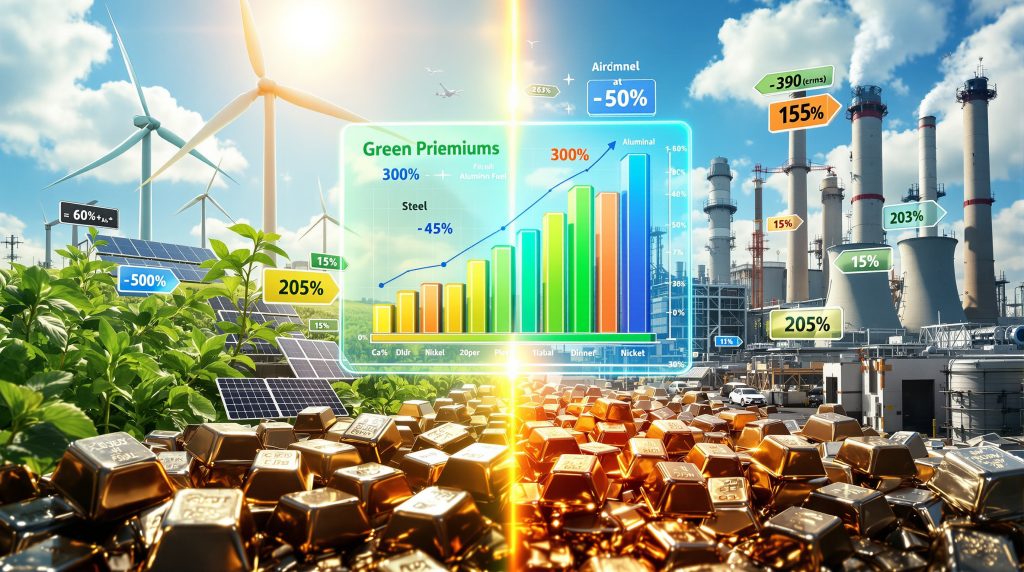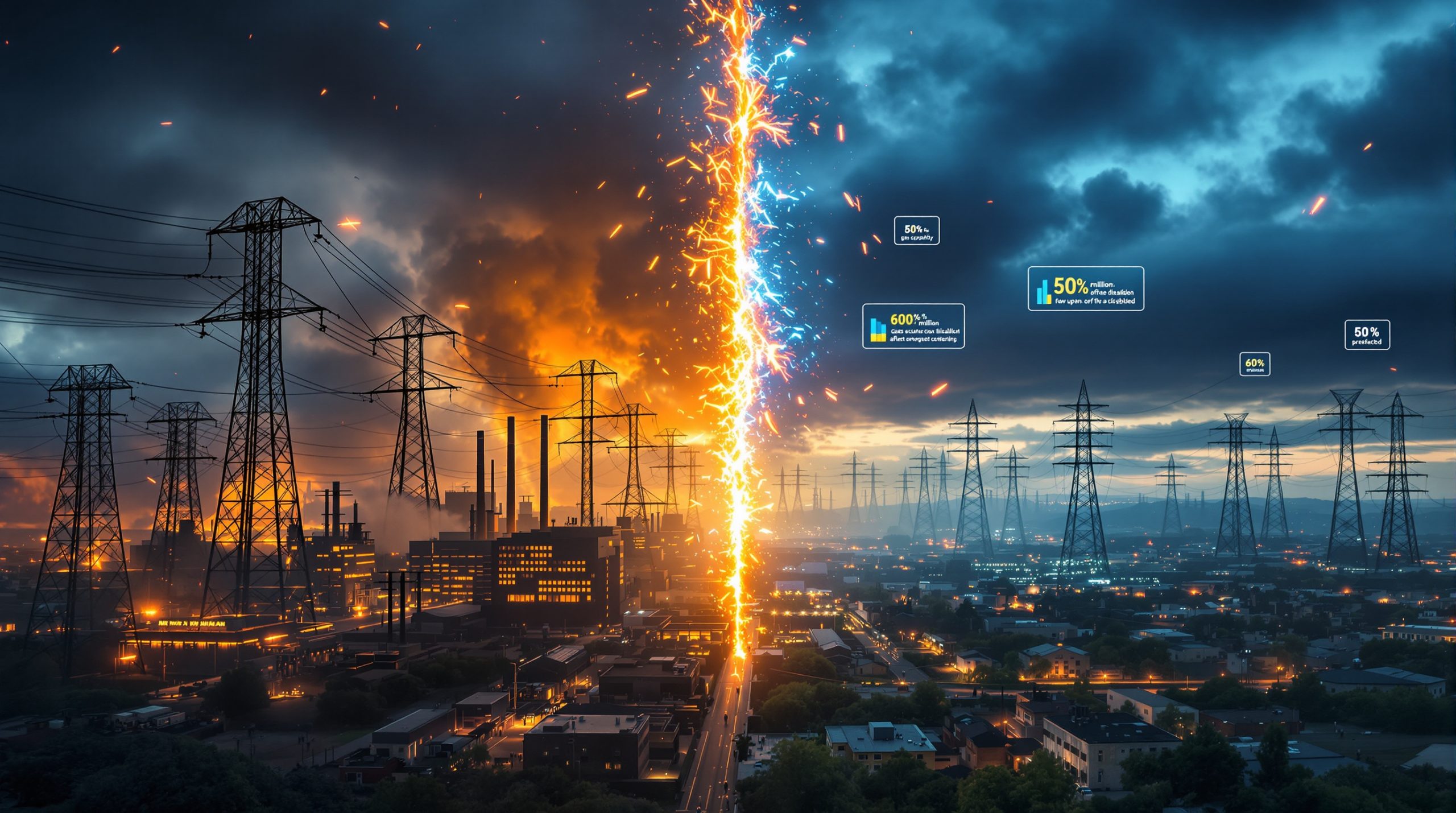Understanding Green Premium Fundamentals
Green premiums represent the additional financial burden that sustainable alternatives impose compared to conventional options in today's marketplace. This cost differential reflects the economic reality where environmentally responsible technologies require higher capital investments, specialised manufacturing processes, and developing supply networks that haven't achieved large-scale efficiencies.
The concept extends beyond simple price comparisons to encompass the true economic cost of environmental responsibility. Furthermore, modern markets increasingly recognise these premiums as essential components of the transition toward sustainable industrial practices, with trading platforms now establishing standardised metrics for green product classification.
Critical Characteristics of Green Premium Markets:
- Price gaps between sustainable and traditional alternatives
- Reflection of genuine environmental compliance costs
- Significant variation across sectors and applications
- Direct correlation with technology advancement stages
The London Metal Exchange's recent establishment of Commodity Pricing and Analysis Ltd in Dubai demonstrates institutional recognition of green premiums as permanent market features. This initiative leverages responsible sourcing criteria and digital trading platform data to create standardised premium calculations, starting with nickel markets where carbon footprint thresholds below 20 metric tons per ton of metal define green classification.
Recent market activity shows substantial trading volumes in sustainable metals. In addition, digital platform Metalshub processed over $220 million worth of Class I refined nickel transactions in 2023, with 488 tons of environmentally certified nickel traded since March 2024, establishing concrete benchmarks for premium calculations.
How Are Green Premiums Calculated Across Different Industries?
Premium calculation methodologies vary significantly depending on sector-specific requirements and measurement standards. The fundamental approach compares sustainable option pricing against conventional alternatives, though implementation details differ based on industry characteristics and regulatory frameworks.
Standard Mathematical Framework:
Green Premium Percentage = (Sustainable Product Cost – Conventional Product Cost) / Conventional Product Cost × 100
Metal markets have pioneered structured approaches to premium assessment. Consequently, the LME's new pricing administrator employs expert judgment mechanisms when sufficient trading data remains unavailable, assuming green premiums always exist within sustainable metal markets.
Industry-Specific Premium Calculations:
| Sector | Premium Methodology | Key Variables |
|---|---|---|
| Metals Processing | Carbon footprint per ton | Energy source, smelting technology |
| Transportation Fuels | Lifecycle emission analysis | Feedstock origin, production method |
| Industrial Materials | Sustainability certification | Raw material sourcing, manufacturing process |
| Energy Generation | Grid integration costs | Storage requirements, transmission infrastructure |
The nickel market's carbon footprint threshold of 20 metric tons per ton provides a concrete example of quantifiable green standards. This benchmark enables precise premium calculations based on measurable environmental impacts rather than subjective sustainability claims.
Why Do Green Premiums Exist in Today's Markets?
Multiple interconnected market forces sustain green premium structures across various industries. These fundamental drivers explain persistent price differentials despite increasing environmental consciousness and technological advancement.
Technology Development Investment Requirements
Research and development costs for clean technologies impose significant upfront expenses that manufacturers must recover through premium pricing. Patent licensing fees for innovative processes add additional cost burdens, while new facility construction requires higher capital expenditures compared to conventional alternatives.
Supply Chain Constraint Factors
Limited availability of sustainable raw materials creates scarcity-driven pricing pressure. Processing infrastructure for environmentally certified products remains underdeveloped, while specialised transportation requirements for green alternatives increase logistics costs.
Production Scale Economics
Sustainable alternatives typically operate at lower production volumes than established conventional options, preventing economies of scale realisation. Higher per-unit fixed costs across smaller manufacturing operations contribute to premium persistence, while inability to leverage mass production efficiencies maintains cost differentials.
Current copper price outlook dynamics illustrate these principles clearly. Chilean producer Codelco increased its 2026 European delivery premium to $325 per ton, rising from $234 in 2025, while German producer Aurubis implemented similar increases to $315 per ton. These premium adjustments reflect supply chain redistribution challenges and compliance cost pressures.
Which Sectors Show the Highest Green Premiums?
Certain industries face particularly severe green premium challenges due to technical complexity, regulatory requirements, or fundamental production limitations. Understanding these high-premium sectors provides insight into where sustainable alternatives face the greatest economic barriers.
Critical Materials and Specialty Metals
The germanium market exemplifies extreme premium conditions where sustainable sourcing faces geopolitical constraints. Industry specialists report material shortages at any price point, with germanium prices reaching 25-year highs following Chinese export restrictions. Some manufacturers struggle to secure supplies regardless of premium willingness.
Transportation Fuel Alternatives
Sustainable aviation fuel represents one of the most challenging green premium environments, with costs reaching multiple times conventional jet fuel prices. Limited production capacity and complex certification requirements sustain these extreme differentials, while infrastructure constraints prevent rapid scaling.
Base Metal Processing
Aluminium smelting operations with verified low carbon footprints command substantial premiums as manufacturers address scope 3 emission requirements. Industry analysts project aluminium prices above $3,000 per ton, potentially reaching $4,000, compared to current levels around $2,765 per ton, driven partly by sustainable production capacity constraints.
Rare Earth Elements
China's addition of holmium, erbium, thulium, europium, and ytterbium to restricted export lists creates extreme premium conditions for these specialty materials. Most metal traders lack familiarity with these elements, yet they increasingly influence global market dynamics and sustainable technology development.
How Do Government Policies Influence Green Premium Levels?
Policy interventions significantly shape green premium dynamics through various mechanisms that can either amplify or reduce cost differentials between sustainable and conventional alternatives. Government actions create both direct financial impacts and indirect market incentives affecting premium structures.
Strategic Infrastructure Investment Programmes
The Australian government's commitment of A$135 million ($87.4 million) to maintain Trafigura's smelter operations demonstrates direct policy intervention in sustainable metals processing. This investment addresses critical processing capacity shortfalls while supporting domestic sustainable material production capabilities, highlighting Aussie green metals leadership in the sector.
Export Control and Trade Policy Mechanisms
China's germanium export restrictions illustrate how trade policies create artificial scarcity conditions that amplify green premiums. Beijing's expansion of restricted export lists to include additional rare earth elements directly impacts global sustainable technology supply chains and pricing structures.
Processing Capacity Strategic Priorities
Industry leaders emphasise that processing infrastructure matters more than raw material availability for sustainable supply chain security. Trade house executives argue that Western nations need base metal smelting capacity to produce critical materials and break Chinese processing dominance over exotic metals like gallium and germanium.
Carbon Pricing and Regulatory Frameworks
- Direct carbon taxation increases conventional product costs
- Emissions cap systems create financial advantages for clean alternatives
- International border adjustment mechanisms equalise competitive conditions
- Procurement mandates establish guaranteed market demand
The collapse in copper smelting fees, with spot treatment terms turning negative, prompted joint governmental responses from Japan, Spain, and South Korea expressing concerns over raw materials market sustainability.
What Role Do Green Premiums Play in Metal Markets?
Metal markets serve as laboratories for green premium development, with sophisticated trading mechanisms and precise measurement standards enabling detailed premium analysis. These markets demonstrate how sustainability requirements integrate with traditional commodity trading structures.
Copper Market Premium Dynamics
European copper premiums for 2026 deliveries show significant increases reflecting sustainability and supply chain pressures. Codelco's premium rise to $325 per ton and Aurubis's increase to $315 per ton demonstrate how tariff policies and supply redistribution create premium pressure across traditional metal markets.
The copper premium increases signal broader market transformation where tariff-driven inventory movements to the United States force other regions to pay higher premiums for supply security. This redistribution creates artificial scarcity conditions that amplify green premium effects.
Sustainable Nickel Trading Infrastructure
Digital trading platform Metalshub established concrete frameworks for green nickel transactions, processing over $220 million in Class I refined nickel during 2023. The platform's definition of green nickel as metal with carbon footprints below 20 metric tons per ton creates measurable sustainability standards.
Since March 2024, Metalshub facilitated 488 tons of certified green nickel trades, providing sufficient transaction data to support systematic premium calculations. This trading volume demonstrates market appetite for sustainable metal alternatives despite premium costs.
Aluminium Market Transformation Indicators
Aluminium market sentiment shifted dramatically toward bullish outlooks as supply dynamics change fundamentally. China's maintained smelter capacity restrictions combined with growing demand concerns create conditions where sustainable production commands increasing premiums.
Consultancy projections for aluminium prices exceeding $3,000 per ton, potentially reaching $4,000, reflect supply constraint recognition and sustainable production capacity limitations. These price projections incorporate premium expectations for environmentally certified aluminium production.
Critical Materials Supply Chain Disruption
Rare earth export controls demonstrate how geopolitical factors amplify green premiums for critical materials. China's dominance over exotic metal processing creates vulnerability points where export restrictions generate extreme premium conditions for energy transition minerals.
How Are Companies Reducing Green Premiums Through Innovation?
Organisations implement various strategies to narrow green premium gaps through technological advancement, operational efficiency improvements, and strategic collaboration arrangements. These approaches address fundamental cost drivers while maintaining environmental performance standards.
Processing Technology Optimisation
Companies develop more efficient production methods that reduce energy consumption and waste generation. Integration of renewable energy sources into manufacturing processes helps lower carbon footprints whilst potentially reducing operating costs over time. This aligns with broader sustainable mining transformation initiatives across the industry.
Strategic Partnership and Infrastructure Development
Industry collaboration through consortiums enables shared infrastructure investments that distribute premium reduction costs across multiple participants. Long-term supply agreements provide volume certainty that supports larger-scale sustainable production facilities.
Market Structure Innovation
Traditional benchmark pricing systems face challenges as smelters explore bilateral agreements and tolling contracts with miners and traders. These alternative arrangements may provide more flexible approaches to managing green premium costs whilst maintaining supply security.
Japan, Spain, and South Korea's joint statement regarding copper processing fees reflects industry recognition that current market structures may require fundamental changes to accommodate sustainable processing requirements.
Technology Breakthrough Development
- Advanced catalyst technologies for cleaner processing methods
- Alternative feedstock development reducing raw material constraints
- Energy storage and conversion efficiency improvements
- Circular economy integration reducing waste costs
The collapse in copper smelting margins, with spot treatment terms turning negative, forces structural innovation in processing arrangements. Companies explore new commercial models that better align sustainable processing costs with market pricing mechanisms.
What Are the Long-Term Projections for Green Premium Evolution?
Market forecasting indicates significant green premium reduction potential over the next decade as technologies mature and production capacity expands. However, timeline projections vary considerably across different sectors and material categories.
Copper Market Demand Surge Projections
Wood Mackenzie forecasts 24% global copper demand growth by 2035, with disruptive sectors like data centres potentially amplifying demand and price volatility beyond current expectations. This demand growth may initially sustain green premiums before production scaling reduces cost differentials.
Aluminium Supply-Demand Rebalancing Timeline
Industry analysts express growing concerns about aluminium supply adequacy for the first time in decades. China's maintained smelter capacity restrictions combined with accelerating demand create conditions where sustainable production premiums may persist longer than previously anticipated.
Critical Materials Geopolitical Evolution
Rare earth market dynamics suggest premium persistence through continued Chinese processing dominance. Where germanium experiences extreme premiums today, gallium and other critical minerals may follow similar patterns, sustaining elevated costs for sustainable technology inputs.
Market Sentiment and Investment Flow Implications
Copper markets show strong bullish sentiment with funds reallocating toward hard assets amid dysfunctional raw materials markets. Low inventory levels resulting from global redistribution to the United States support arguments for sustained premium conditions.
Projected Premium Reduction Scenarios:
| Timeline | Expected Premium Changes | Primary Drivers |
|---|---|---|
| 2025-2027 | 15-25% reduction | Technology scaling, policy support |
| 2028-2030 | 35-50% reduction | Infrastructure development, market maturity |
| 2031-2035 | 60-75% reduction | Full-scale production, regulatory integration |
Note: These projections represent general market expectations and may vary significantly based on technological breakthroughs, policy changes, and geopolitical developments.
How Do Green Premiums Impact Investment Decisions?
Investment professionals increasingly incorporate green premium analysis into portfolio construction and risk management processes. These premiums represent both opportunity identification mechanisms and risk assessment factors across various asset classes and sectors.
Market Psychology and Sentiment Analysis
Copper markets demonstrate strong bullish sentiment with the metal consistently topping LME seminar polls for price upside potential. Even traditionally contrarian analysts acknowledge robust long-term demand growth combined with supply challenges, indicating widespread recognition of premium sustainability.
Fund Allocation Strategy Shifts
Investment funds increasingly reallocate capital toward hard assets amid recognition of dysfunctional raw materials markets. This reallocation reflects understanding that green premiums represent structural market features rather than temporary pricing anomalies.
Risk Assessment Framework Evolution
- Premium volatility affects project economic modelling
- Regulatory changes rapidly alter cost structure assumptions
- Technology disruption may eliminate entire premium categories
- Geopolitical factors create supply chain vulnerability points
Opportunity Recognition Mechanisms
Companies successfully reducing green premiums gain competitive advantages that translate into investment performance. First-mover advantages in emerging green markets provide portfolio differentiation opportunities, while supportive policy frameworks create favourable investment environments.
Sector-Specific Investment Implications
The aluminium market's bullish sentiment reversal demonstrates how supply constraint recognition affects investment positioning. Analysts worry about supply growth adequacy for the first time in decades, creating investment opportunities in sustainable aluminium production capacity.
What Strategies Help Businesses Navigate Green Premium Challenges?
Organisations can implement comprehensive approaches to manage green premium impacts whilst advancing sustainability objectives and maintaining competitive market positioning. These strategies address both cost management and strategic advantage development.
Supply Chain Security and Diversification
Securing long-term green supply agreements provides cost predictability whilst ensuring sustainable material availability. Alternative supplier relationship development reduces dependency on single sources, while vertical integration opportunities offer direct control over sustainable production processes.
Customer Education and Market Positioning
Educating markets about the green premium helps justify costs through broader value proposition communication. Highlighting non-financial benefits of sustainable choices, including regulatory compliance and brand value enhancement, supports premium product positioning strategies.
Commercial Structure Innovation
The current benchmark pricing system faces potential transformation as smelters explore bilateral agreements and tolling contracts. These alternative commercial arrangements may provide more flexible approaches to managing sustainable processing costs whilst maintaining supply security.
Strategic Partnership Development
- Technology provider collaboration for innovation access
- Industry consortium participation for shared infrastructure investment
- Policy maker engagement for supportive regulatory framework development
- Research institution partnerships for advancement acceleration
Processing Capacity Strategic Considerations
Industry experts emphasise processing infrastructure criticality over raw material availability for supply chain security. Organisations investing in sustainable processing capabilities position themselves advantageously as geopolitical tensions affect traditional supply sources, incorporating mine reclamation innovation into their long-term strategies.
The joint governmental statement from Japan, Spain, and South Korea regarding copper processing market sustainability demonstrates how industry collaboration can influence policy responses to green premium challenges.
Future Outlook: When Will Green Premiums Disappear?
The trajectory toward green premium elimination varies dramatically across sectors and material categories. Some industries approach cost parity whilst others face persistent structural challenges requiring continued innovation and policy intervention.
Near-Term Market Dynamics (2025-2027)
Current commodity prices reflect ongoing premium pressures with copper at $5.025/lb, aluminium futures at $2,722.75/ton, and precious metals showing strong performance. Gold futures reaching $4,366.70/ozt and silver at $51.425/ozt indicate investor flight toward tangible assets amid market uncertainty.
Critical Materials Outlook Evolution
Rare earth elements represent central tension points between major economies, with germanium scarcity demonstrating current premium extremes. Five additional elements now face Chinese export restrictions: holmium, erbium, thulium, europium, and ytterbium, despite most traders lacking familiarity with these materials.
Sector-Specific Premium Elimination Timelines:
Renewable Energy Systems: Many regions approaching grid parity conditions
Electric Transportation: Cost competitiveness expected between 2027-2030
Sustainable Aviation Fuels: Premium persistence likely through 2035 due to certification complexity
Green Hydrogen Production: Market competitiveness projected for 2030-2035
Processing Infrastructure Development
The Western world's recognition that processing capacity matters more than raw material reserves suggests sustained investment in sustainable smelting and refining facilities. Australia's A$135 million commitment to Trafigura's operations exemplifies governmental recognition of processing infrastructure strategic importance.
Market Structure Transformation Indicators
Traditional commodity pricing mechanisms face fundamental challenges as negative copper treatment terms force structural innovation. The evolution toward bilateral agreements and tolling contracts may create more flexible premium management approaches whilst supporting sustainable processing development.
Geopolitical Factor Integration
China's continued expansion of restricted export lists affects global sustainable technology supply chains. Future premium elimination depends partly on Western nations developing alternative processing capabilities for critical materials currently dominated by Chinese production.
Investment Flow and Market Maturity
Strong bullish sentiment across copper and aluminium markets reflects recognition of structural supply constraints and demand growth. These conditions may sustain green premiums longer than technology advancement alone would suggest, particularly for materials requiring significant infrastructure investment.
The ultimate elimination of green premiums represents a critical milestone in achieving widespread sustainability adoption. Success requires coordinated efforts across technology development, policy implementation, and market transformation initiatives, with timelines varying significantly based on sector-specific challenges and advancement opportunities.
Disclaimer: The projections and analysis presented in this article are based on current market conditions and industry forecasts as of October 2025. Actual outcomes may vary significantly due to technological breakthroughs, policy changes, geopolitical developments, and unforeseen market dynamics. Readers should conduct independent research and consult with qualified professionals before making investment or business decisions based on this information.
Want to Capitalise on Green Premium Investment Opportunities?
Discovery Alert's proprietary Discovery IQ model delivers real-time alerts on significant ASX mineral discoveries, including critical materials and green metals that command substantial premiums in today's markets. Subscribers gain immediate access to actionable investment opportunities as companies announce discoveries in copper, rare earths, and other essential materials driving the sustainability transition, positioning themselves ahead of broader market recognition. Begin your 30-day free trial today to secure your market-leading advantage in the evolving green metals landscape.




